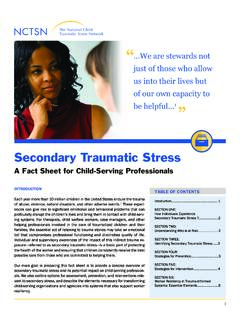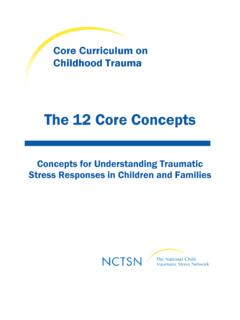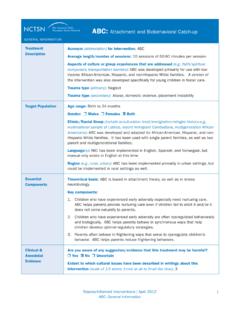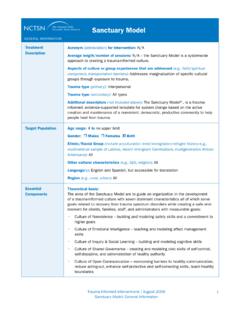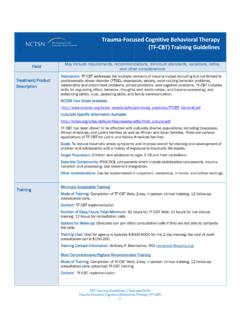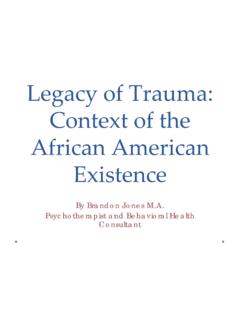Transcription of Making the Connection: Trauma and Substance Abuse
1 The National Child Traumatic Stress Making the Connection: Trauma and Substance AbuseWhen Mary was 11, her mother left this man, Dave to babysit. Dave gave her a joint. It made me happy. It made me feel like nothing could touch me and everything was OK. So I started stealing my mum s drugs. Of course, she was caught and locked in a closet. I was in there for almost two days. After that happened, I guess a part of me changed. I didn t care for anybody. I hated the world after that. 1 Data from the most recent National Survey of Adolescents and other studies indicate that one in four children and adolescents in the United States experiences at least one potentially traumatic event before the age of 162, and more than % of 7-year-olds one in eight have experienced posttraumatic stress disorder (PTSD) at some point in their lives. Most, if not all, of these young people also have access to a wide range of psychoactive substances that can both dull the effects of stress and place teens at increased risk of experiencing Trauma .
2 It is estimated that 29% of adolescents nearly one in three have experimented with illegal drugs by the time they complete 8th grade, and 4 % have consumed For many adolescents, such early experimentation eventually progresses to Abuse of or dependence on illicit drugs or alcohol. Every year, approximately one in five American adolescents between the ages of 12 and 17 engages in abusive/dependent or problematic use of illicit drugs or ,6 Although it is unclear exactly how many adolescents who Abuse drugs or alcohol also have experienced Trauma , numerous studies have documented a correlation between Trauma exposure and Substance Abuse in adolescents:n In the National Survey of Adolescents, teens who had experienced physical or sexual Abuse /assault were three times more likely to report past or current Substance Abuse than those without a history of Trauma n In surveys of adolescents receiving treatment for Substance Abuse , more than 70% of patients had a history of Trauma exposure7,8 This correlation is particularly strong for adolescents with PTSD.
3 Studies indicate that up to 59% of young people with PTSD subsequently develop Substance Abuse Understanding the Links Between Adolescent Trauma and Substance AbuseJune 20082 Traumatic Stress and Substance Use: A Complex RelationshipMultiple pathways have been proposed to explain the temporal link between Trauma and Substance Abuse in adolescents. 2 A review of these theories demonstrates that the road connecting these disorders runs both ways: Trauma increases the risk of developing Substance Abuse , and Substance Abuse increases the likelihood that adolescents will experience as a risk factor for Substance abuseAccording to the self-medication hypothesis of Substance Abuse , people develop Substance Abuse problems in an attempt to manage distress associated with the effects of Trauma exposure and traumatic stress symptoms. This theory suggests that youth turn to alcohol and other drugs to manage the intense flood of emotions and traumatic reminders associated with traumatic stress or PTSD, or to numb themselves from the experience of any intense emotion, whether positive or studies have found that Substance use developed following Trauma exposure (25% 76%) or the onset of PTSD ( 4% 59%) in a high proportion of teens with Substance Abuse Recent research in this area also suggests that traumatic stress or PTSD may make it more difficult for adolescents to stop using, as exposure to reminders of the traumatic event have been shown to increase drug cravings in people with co-occurring Trauma and Substance Abuse .
4 , 4 (For more information on Trauma reminders, see Understanding Traumatic Stress in Adolescents: A Primer for Substance Abuse Professionals.) Substance Abuse as a risk factor for traumaNumerous epidemiological studies have found that, for many adolescents (45% 66%), Substance use disorders precede the onset of Trauma Studies have shown a direct link between alcohol use and engagement in risky behaviors in which adolescents may get hurt 0, such as hitchhiking, walking in unsafe neighborhoods, and driving after using alcohol or drugs. 5 According to the most recent National Survey on Drug Use and Health, more than 25% of underage drinkers are binge or heavy drinkers, and approximately 20% one in five report driving while under the influence during the past Not surprisingly, adolescents with Substance Abuse disorders are also significantly more likely than their non- Substance abusing peers to experience traumas that result from risky behaviors, including harm to themselves or witnessing harm to There is also evidence that youth who are already abusing substances may be less able to cope with a traumatic event as a result of the functional impairments associated with problematic use.
5 In one study, investigators found that even after controlling for exposure to Trauma , adolescents with Substance Abuse disorders were two times more likely to develop PTSD following Trauma than were their non-abusing peers. The researchers suggested that the extensive psychosocial impairments found in adolescents with Substance Abuse The National Child Traumatic Stress occurred in part because they lacked the skills necessary to cope with Trauma exposure. 0 Regardless of the pathway describing the onset of Trauma exposure or PTSD and the development of Substance Abuse problems, youth with this co-occurrence experience dif ficulties with emotional and behavioral regulation that make it all the more difficult for them to stop using. A successful treatment approach must therefore be flexible enough to accommodate the multiple ways in which Trauma and Substance Abuse may be related. Addressing the Needs of Adolescents with Co-occurring Trauma and Substance Abuse For adolescents dealing with the effects of traumatic stress or PTSD, alcohol and/or drugs initially may seem to alleviate distress, either through the increased pleasurable sensations or through the avoidance of intense emotions that may follow stressful experiences.
6 In the long run, however, Substance use perpetuates a cycle of problem behaviors that can make it more dif ficult to recover after a traumatic event. For teenagers struggling with Substance Abuse and traumatic stress, the negative effects and consequences of one disorder compound the problems of the other. Although such teenagers need help, often desperately, they frequently have difficulty entering or staying involved in treatment services. Usually teenagers attend such facilities against their will because they are either mandated to attend treatment ( , by the courts), referred by teachers, or brought in by their parents. Raphael s* StoryRaphael was a 5-year-old boy with a history of truancy and drug involvement (marijuana use and drug dealing). He had been placed in a group home after Child Protective Services became involved with the family and his mother and stepfather asserted that they couldn t control the group home, Raphael was angry, threatening, and unwilling to cooperate with group activities.
7 He was disruptive during group therapy sessions and initially refused to say much during individual treatment sessions. Through patience, openness, and a willingness to explore Raphael s interests including his flair for developing spontaneous rhymes and rap-style lyrics Raphael s therapist was gradually able to engage Raphael in the treatment time, Raphael opened up about his difficult relationship with his mother, being frequently hit and locked in a dark closet by his stepfather, and his conflicted relationship with his younger sister. He also talked about his frequent, almost daily, use of marijuana and alcohol and how they made him feel better and on top of things. It became clear that, for Raphael, alcohol and marijuana served as tools that enabled him to numb overwhelming feelings and to feel dominant in uncomfortable or threatening social situations. As Raphael and his therapist began to address his Trauma and Substance Abuse histories, Raphael started to develop better tools for coping with the intense feelings and impulses that contributed to his most pressing problems.
8 * Raphael is a composite representation based on real teenage clients struggling with traumatic stress and Substance the Links Between Adolescent Trauma and Substance AbuseJune 20084 Because the service systems targeting Substance Abuse and mental health problems have traditionally been fragmented, few teenagers with both traumatic stress and Substance Abuse problems receive integrated treatment services. Compounding the problem is that there are few facilities offering integrated services, primarily because few professional training programs in Substance Abuse or mental health provide clinicians with the education necessary to develop expertise in both Trauma and Substance Abuse treatment, and few professionals have training and experience across both the strong link between Trauma and Substance Abuse among adolescents, however, the majority of both Substance Abuse and mental health professionals have encountered this population. Providing adequate and effective care to adolescents who are grappling with Substance Abuse and Trauma will require adjustments on the part of both mental health providers, it is critical to become familiar with the patterns of addiction associated with substances of Abuse , and to recognize that similar patterns are at work in traumatic stress and addiction.
9 Both are characterized by emotional and behavioral dysregulation, and are expressed in a range of symptoms and behaviors that can include classic posttraumatic stress symptoms, Substance Abuse , and other risky behaviors. For Substance Abuse professionals, it is important to look beyond the immediate circumstances of the youth s Substance use and pay attention to his or her Trauma history and its relationship to his or her current emotional difficulties and coping patterns (including Substance use). There are many commonalities between the ways in which youth respond to Substance Abuse triggers and the ways in which they respond to reminders of loss and Trauma . Compiling a list of triggers that may lead to emotional dysregulation and Substance use, and incorporating possible reminders of previous Trauma and loss can be helpful. Overcoming Common Challenges to CareClinicians, administrators, and other healthcare providers in the Substance Abuse and mental health fields often face major challenges in providing care to youth with traumatic stress and Substance Abuse problems.
10 For example, the fragmentation that has traditionally existed between mental health and Substance Abuse systems often limits the types of services that youth are eligible to receive. Additionally, service centers may lack the resources or support necessary to provide comprehensive services. Although it may not be possible to find solutions to many of these challenges, below are some solutions to common treatment National Child Traumatic Stress SOLUTIONLack of institutional awareness and prioritization of adolescent Trauma and Substance use assessment and treatmentThe materials in this toolkit can serve as resources to aid in raising institutional awareness of the need for sound Substance Abuse and Trauma assessment and treatment. Presenting case material that highlights the relationships between Trauma and Substance Abuse can also help raise institutional awarenessClinician lack of familiarity with the common presentations of posttraumatic stress symptoms in adolescentsUse the materials in this toolkit to help become familiar with the common presentations of posttraumatic stress symptoms in adolescents.
